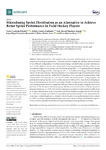Mostrar o rexistro simple do ítem
Microdosing sprint distribution as an alternative to achieve better sprint performance in field hockey players
| dc.contributor.author | Martín Acero, Rafael | |
| dc.contributor.author | Cuadrado-Peñafiel, Víctor | |
| dc.contributor.author | Castaño Zambudio, Adrián | |
| dc.contributor.author | Martínez-Aranda, Luis Manuel | |
| dc.contributor.author | González-Hernández, Jorge M. | |
| dc.contributor.author | Jíménez Reyes, Pedro | |
| dc.date.accessioned | 2023-05-11T12:15:14Z | |
| dc.date.available | 2023-05-11T12:15:14Z | |
| dc.date.issued | 2023-01-06 | |
| dc.identifier.citation | Cuadrado-Peñafiel, V.; Castaño-Zambudio, A.; Martínez-Aranda, L.M.; González-Hernández, J.M.; Martín-Acero, R.; Jiménez-Reyes, P. Microdosing Sprint Distribution as an Alternative to Achieve Better Sprint Performance in Field Hockey Players. Sensors 2023, 23, 650. https:// doi.org/10.3390/s23020650 | es_ES |
| dc.identifier.issn | 1424-8220 | |
| dc.identifier.uri | http://hdl.handle.net/2183/33059 | |
| dc.description.abstract | [Abstract]: Introduction: The implementation of optimal sprint training volume is a relevant component of team sport performance. This study aimed to compare the efficiency and effectiveness of two different configurations of within-season training load distribution on sprint performance over 6 weeks. Methods: Twenty male professional FH players participated in the study. Players were conveniently assigned to two groups: the experimental group (MG; n = 11; applying the microdosing training methodology) and the control group (TG; n = 9; traditional training, with players being selected by the national team). Sprint performance was evaluated through 20 m sprint time (T20) m and horizontal force–velocity profile (HFVP) tests before (Pre) and after (Post) intervention. Both measurements were separated by a period of 6 weeks. The specific sprint training program was performed for each group (for vs. two weekly sessions for MG and TG, respectively) attempting to influence the full spectrum of the F-V relationship. Results: Conditional demands analysis (matches and training sessions) showed no significant differences between the groups during the intervention period (p > 0.05). No significant between-group differences were found at Pre or Post for any sprintrelated performance (p > 0.05). Nevertheless, intra-group analysis revealed significant differences in F0, Pmax, RFmean at 10 m and every achieved time for distances ranging from 5 to 25 m for MG (p < 0.05). Such changes in mechanical capabilities and sprint performance were characterized by an increase in stride length and a decrease in stride frequency during the maximal velocity phase (p < 0.05). Conclusion: Implementing strategies such as microdosed training load distribution appears to be an effective and efficient alternative for sprint training in team sports such as hockey. | es_ES |
| dc.description.sponsorship | Agencia Estatal de Investigación (AEI); PID2019-108972RA-100 | es_ES |
| dc.language.iso | eng | es_ES |
| dc.publisher | MDPI | es_ES |
| dc.relation.uri | https:// doi.org/10.3390/s23020650 | es_ES |
| dc.rights | Atribución 3.0 España | es_ES |
| dc.rights.uri | http://creativecommons.org/licenses/by/3.0/es/ | * |
| dc.subject | Microdosing | es_ES |
| dc.subject | Sprint performance | es_ES |
| dc.subject | Team sports | es_ES |
| dc.subject | Field hockey | es_ES |
| dc.subject | Training load distribution | es_ES |
| dc.title | Microdosing sprint distribution as an alternative to achieve better sprint performance in field hockey players | es_ES |
| dc.type | info:eu-repo/semantics/article | es_ES |
| dc.rights.access | info:eu-repo/semantics/openAccess | es_ES |
| UDC.journalTitle | Sensors | es_ES |
| UDC.volume | 23 | es_ES |
| UDC.issue | 2 | es_ES |
Ficheiros no ítem
Este ítem aparece na(s) seguinte(s) colección(s)
-
GI- ACOM - Artigos [40]






